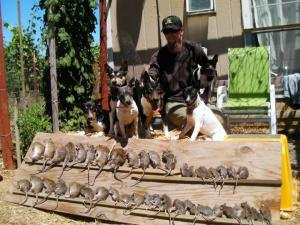2016 - Volume #BFS, Issue #16, Page #46
[ Sample Stories From This Issue | List of All Stories In This Issue | Print this story
]
Rat Hunter Provides Needed Service In California
 |
Through word of mouth and recent media attention, “Jreed and his Mongrol Hoard” have found plenty of demand for their services over the past 5 years. For about $75 (and a case of beer) Reed and his dogs spend 3 or 4 hours diminishing rat problems for mostly small farmers with chickens, organic crops or composting facilities.
Concerns about rats are real, Reed says, noting they destroy feed, chew wiring and defecate in living spaces, spread diseases, steal eggs and kill chicks and other small animals. Rats thrive in California’s warm climate, but many producers can’t or don’t want to use poison.
His rat hunting business evolved after a terrier he owned killed rats that were after Reed’s chickens. Reed started encouraging other dogs to do the same.
While the dogs are good hunters, they need human help to choreograph where they go. When Reed is hired, he requests the customer provide a couple of adults or teens to help. If they can’t, he brings a couple of friends along for an extra fee.
“I follow the lead of one adult dog. I’m like the ringmaster,” Reed says, directing dogs. “I have experience to see how much food is available and how many rats there might be.” He also knows where they’re hiding - under pallets and bales, and in double walls, for example.
On average he and his dogs find and kill 20 to 30 rats on a hunt at a small farm. Reed’s record was 121 rats at a compost facility, where owners thought it was rat-proof.
No place is rat-proof, Reed says, and he turns clients down who have filthy farms and poor animal husbandry practices or refuse to clean up their property and make necessary improvements - build coops 18 in. off the ground, eliminate double walls, store food in metal cans overnight, and don’t store kitchen compost near housing, for example.
Norway rats also live in tunnels and can hold their breath a long time so drowning doesn’t usually work. Exhaust from a chainsaw or vehicle is more effective to show where tunnels go. Then the strategy comes down to blocking exits and digging with a shovel.
Reed says property owners can use other breeds of working farm dogs to control rats on their own property.
“If you’re looking for a rodent dog, get a terrier from a farm where its parents’ behavior is observable. Mixed breeds and pound dogs are good at this too,” he explains. “You have to be interested in it yourself. You have to actively take a part in going after the rats on your farm - and your dog must be interested in following along.”
Rat hunting is not for everyone, Reed admits and it’s hard work - shoveling, moving things and keeping track of as many as 12 dogs at a time when he is working with others. But it’s rewarding to see his dogs at work and enjoying it.
Contact Jordon through Facebook. Search: Jreed and his Mongrol Hoard

Click here to download page story appeared in.
To read the rest of this story, download this issue below or click here to register with your account number.




